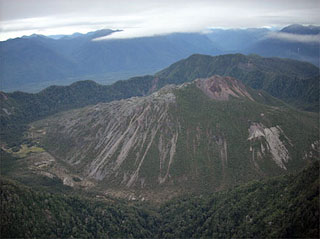Report on Chaiten (Chile) — 8 July-14 July 2009
Smithsonian Institution / US Geological Survey
Weekly Volcanic Activity Report, 8 July-14 July 2009
Managing Editor: Sally Sennert.
Please cite this report as:
Global Volcanism Program, 2009. Report on Chaiten (Chile) (Sennert, S, ed.). Weekly Volcanic Activity Report, 8 July-14 July 2009. Smithsonian Institution and US Geological Survey.
Chaiten
Chile
42.8349°S, 72.6514°W; summit elev. 1122 m
All times are local (unless otherwise noted)
Based on web camera views from the S, SERNAGEOMIN reported that during 3-8 July gas-and-ash plumes rose 1.5 km from Chaitén's growing Domo Nuevo 1 and Domo Nuevo 2 lava-dome complex. Collapses originating from unstable slopes generated block-and-ash flows, particularly in the W area of the complex. The Alert Level remained at Red. Based on web camera views and a SIGMET notice, the Buenos Aires VAAC reported that on 10 July ash plumes rose to altitudes of 1.8-2.4 km (6,000-8,000 ft) a.s.l. and drifted NE. A thermal anomaly was also seen in satellite imagery on 11 June.
Geological Summary. Chaitén is a small caldera (~3 km in diameter) located 10 km NE of the town of Chaitén on the Gulf of Corcovado. Multiple explosive eruptions throughout the Holocene have been identified. A rhyolitic obsidian lava dome occupies much of the caldera floor. Obsidian cobbles from this dome found in the Blanco River are the source of artifacts from archaeological sites along the Pacific coast as far as 400 km from the volcano to the N and S. The caldera is breached on the SW side by a river that drains to the bay of Chaitén. The first recorded eruption, beginning in 2008, produced major rhyolitic explosive activity and building a new dome and tephra cone on the older rhyolite dome.
Sources: Servicio Nacional de Geología y Minería (SERNAGEOMIN), Buenos Aires Volcanic Ash Advisory Center (VAAC)

